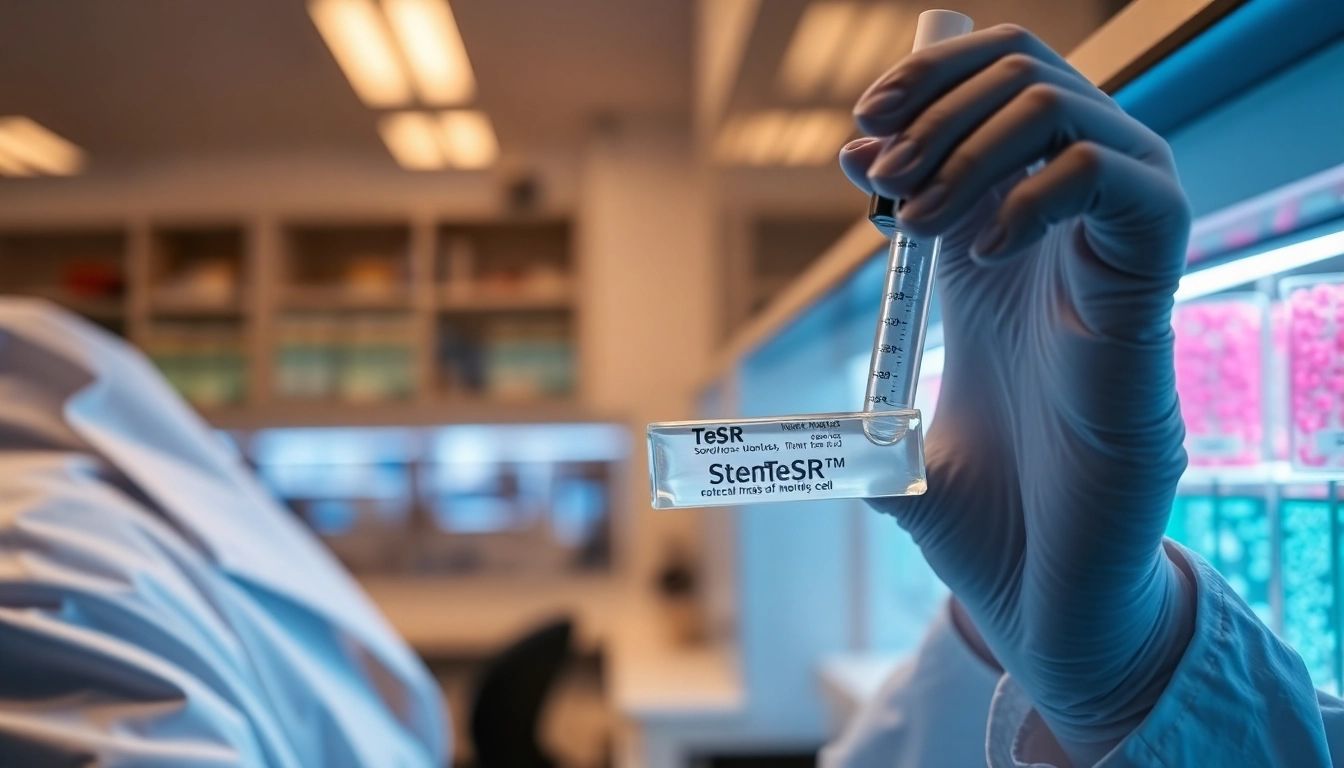Introduction to TeSR™ Media
The advent of pluripotent stem cell (PSC) research has revolutionized the field of regenerative medicine and developmental biology, providing unprecedented opportunities for the investigation of cellular processes and therapeutic applications. A pivotal aspect of cultivating PSCs lies in the choice of culture media. TeSR™ media, comprising feeder-free pluripotent stem cell culture systems, have gained recognition for their ability to foster the growth and differentiation of human embryonic stem (hES) and induced pluripotent stem (iPS) cells. These specialized media are designed to minimize variability, enhance cell quality, and streamline research workflows.
What is TeSR™ Media?
TeSR™ media are a range of feeder-free culture media meticulously formulated for the maintenance and differentiation of human pluripotent stem cells. The TeSR™ brand, developed by STEMCELL Technologies, offers a comprehensive suite of products that support various stages of stem cell research—from reprogramming to maintenance and differentiation. This range includes formulations such as mTeSR™ Plus, TeSR™-E8™, TeSR™-AOF, and several others, each designed to provide optimal conditions tailored to specific cell types and research goals.
Importance of Feeder-Free Culture Systems
Feeder-free culture systems have emerged as a critical innovation in stem cell biology, addressing several challenges posed by traditional feeder-layer conditions. They eliminate variability introduced by animal-derived substrates and enhance reproducibility in experiments. By using defined formulations of nutrients and growth factors, researchers can maintain cell line integrity and pluripotency in a more controlled environment. This not only simplifies protocols but also aligns with regulatory demands for translational research, making feeder-free systems more favorable for future clinical applications.
Overview of Applications in Research
The applications of TeSR™ media extend beyond simple maintenance of PSCs. These cultured cells can be directed towards differentiation into specific cell lineages, including cardiac, neuronal, and hematopoietic cells. Moreover, they serve essential roles in drug discovery, toxicity testing, and regenerative therapies. The ability to consistently generate high-quality cells using TeSR™ media enhances the reliability of experimental outcomes, paving the way for breakthroughs in biomedical research.
Different Types of TeSR™ Media
STEMCELL Technologies has developed a variety of TeSR™ media to cater to specific research needs, each with unique formulations and applications.
mTeSR™ Plus: Elevating Stem Cell Research
mTeSR™ Plus is a sophisticated version of the original mTeSR™1 medium, designed for enhanced stability and performance. One of its most significant advantages is its formulation that supports weekend-free schedules through improved pH buffering, which helps maintain cell health during media changes. This medium is particularly useful for researchers looking for a hassle-free, dependable culture solution that requires less frequent interventions.
TeSR™-E8™ and Its Unique Benefits
TeSR™-E8™ represents a leap forward in minimizing protein content while still providing essential support for hPSCs. It is based on a streamlined formulation that includes only the most critical components needed for hPSC maintenance, allowing for simplicity without sacrificing performance. Researchers utilizing TeSR™-E8™ can benefit from reduced variability and optimized growth conditions, making it an attractive choice for both academic and clinical studies.
Comparing TeSR™-AOF and Other Variants
TeSR™-AOF (Animal Origin-Free) sets itself apart by ensuring safety regarding potential viral contamination. It is free from human and animal materials up to the secondary level of manufacturing, providing peace of mind to researchers concerned about contamination risks. This formulation offers an important choice for labs committed to xeno-free processes, further aligning with the growing demand for safe culture systems in therapeutic contexts.
Key Benefits of Using TeSR™ Media
The key benefits of utilizing TeSR™ media in stem cell research are multifaceted, focusing on consistency, cell quality, and streamlined workflows.
Consistency and Reproducibility in Experiments
One of the central advantages of TeSR™ media is their ability to deliver consistent and reproducible results across experiments. This is achieved through rigorous pre-screening of ingredients, ensuring that researchers can rely on uniform performance. By minimizing batch-to-batch variability, TeSR™ media significantly enhance the reliability of experimental data, which is critical in academic research and industry applications.
Enhanced Cell Quality and Viability
TeSR™ media formulations are engineered for optimal cell growth conditions, which promote high viability and pluripotency levels in hPSCs. The presence of key growth factors, antioxidants, and supplements all contribute to an environment that supports cell integrity. Ensuring heightened cell quality allows researchers to conduct more accurate functional assays and differentiate cells into desired lineages with higher efficiency.
Streamlined Workflow for Pluripotent Stem Cells
With the introduction of TeSR™ media, researchers can enjoy a more streamlined protocol that integrates well into existing workflows. These media are designed to facilitate smoother transitions between cell maintenance, differentiation, and cryopreservation phases, thereby reducing the time needed for experimental setups. This efficiency not only saves valuable lab time but also enhances overall productivity in stem cell research.
Application of TeSR™ Media in Differentiation and Reprogramming
The power of TeSR™ media extends to their applications in differentiation and reprogramming, enabling researchers to guide PSCs toward desired cell types.
Guidelines for Successful hPSC Maintenance
To maintain healthy hPSC cultures, specific guidelines must be adhered to. These include maintaining appropriate seeding densities, regularly monitoring cell morphology, and adjusting media changes based on cellular growth rates. Researchers should be trained in sterile techniques to minimize contamination and could employ routine quality assessments such as pluripotency checks through specific marker expression to ensure optimal culture conditions.
Utilizing TeSR™ for Hematopoietic Differentiation
Hematopoietic differentiation from PSCs can be achieved effectively using protocols designed for this purpose, often involving the sequential application of well-defined cytokines and growth factors. Using TeSR™ media, researchers can cultivate and expand precursor populations efficiently before directing them toward hematopoietic lineages. Dr. Joseph C. Wu highlights the importance of optimizing these protocols to consistently yield hematopoietic stem cells from hPSCs.
Challenges and Solutions in Cell Reprogramming
Cell reprogramming involves converting somatic cells into pluripotent cells, a process that poses significant challenges such as low reprogramming efficiency and cellular stress responses. Utilizing TeSR™ reprogramming media such as ReproTeSR™ can streamline this process. Enhancements in reprogramming protocols, including utilizing specific small molecules and epigenetic modifiers, may substantially improve outcomes as evidenced in studies leveraging TeSR™ media.
Future Perspectives and Innovations
The landscape of stem cell technology is ever-evolving, with ongoing research and innovations anticipated in the coming years.
Ongoing Research and Development
Research into refining the formulations of TeSR™ media is continuously advancing. As new discoveries in stem cell biology emerge, the need to adapt and improve existing culture conditions will remain imperative. Investigations focusing on the specific roles of individual cytokines and their interactions within the culture media will likely lead to even more targeted and effective formulations, enhancing differentiation outcomes across various cell types.
Importance of cGMP Compliance
With the increasing transition of PSCs into clinical applications, the relevance of cGMP (current Good Manufacturing Practices) compliance cannot be understated. cGMP ensures that products are consistently produced to high-quality standards, minimizing risks in therapeutic settings. The adoption of cGMP practices in the production of TeSR™ media, particularly mTeSR™ Plus, exemplifies this commitment to safety and efficacy in stem cell research.
Expert Insights from Leading Researchers
Engaging with leaders in stem cell research can provide invaluable insights into overcoming current challenges within the field. Interviews with esteemed researchers such as Dr. Andrew Elefanty and Dr. David Hay reveal the latest breakthroughs in differentiation protocols and scale-up processes that utilize TeSR™ media effectively. Their experiences highlight the importance of collaboration and shared knowledge in advancing the applications of PSC technology.













Leave a Reply